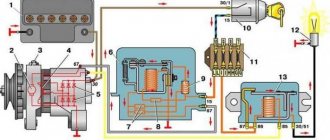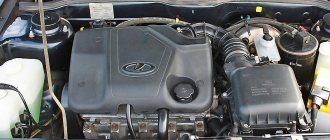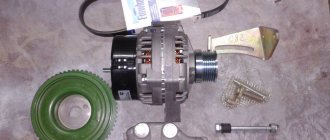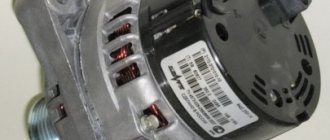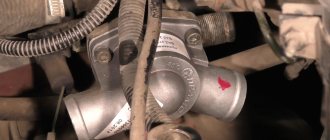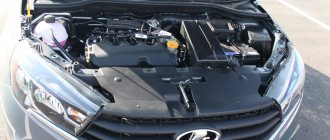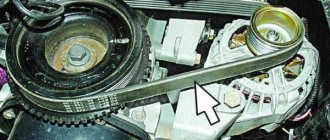The device serves to transform mechanical energy from the crankshaft into electricity. The generator charges the battery and is also a source of alternating current and power for all electrical equipment of the car. It has a diode bridge (rectifiers) and a voltage regulation unit, operating in parallel with the battery.
Standard generator Grants
At the factory, VAZ 2190 and 2191 are equipped with a device with the catalog designation KZATE 115A (9402.3701-14). It has the following technical characteristics:
- rated voltage – 14 V;
- maximum current – 115 A;
- shaft rotation speed – 1200 rpm. (without load);
- shaft rotation speed at a maximum current of 115 A – 6000 rpm.
The main components of the generator are a stationary stator and a rotor rotating in it. The parts are separated from each other by an air gap. Their main working part is the winding and magnetic circuit. Other components serve to provide adequate rigidity, cooling, etc.
The brush assembly is necessary to connect the rotor electrical network to the stationary stator winding; it consists of several graphite contacts. A diode bridge is used to convert AC to DC current and is also called a rectifier block. The regulator converts the output electricity into the desired voltage.
To protect the car's network from surges, a step-down capacitor with a capacity of 2.2 μF is used. After turning on the ignition, voltage is supplied through the control lamp: the battery icon lights up on the instrument panel. After the engine starts, the generator receives power from the rectifier unit: the lamp on the panel goes out.
What generator is installed on - What generator is installed on the Lada Granta from the factory
Today's topic of conversation will be the question - which generator to put on the VAZ 2114 and how to choose it, but before that you need to figure out how it works and on what principle does it work?
Generator for VAZ 2114
The device of a car generator
A generator is a device driven by a car engine through a system of pulleys and a drive belt. Thanks to this rotation, an electric current is generated inside the device, which serves to charge the battery and operate on-board devices.
All car generators consist of the following elements:
- aluminum cover with slots for mounting bearings, terminals and other elements;
- a stator with power windings connecting it to a rectifying device;
- rotor;
- diode rectifier block;
- relay-regulator.
VAZ 2114 generator device
Speaking about which generator is installed on the VAZ 2114, we should immediately mention its performance characteristics:
- output current - 80 A;
- generated voltage - from 13 to 14.7 V;
- sagging of the drive belt under a load of 10 kg is no more than 0.8 cm.
When choosing a new generator for the 14th model, you should give preference to devices with increased current strength - not 80, but 100 or even 120 Amperes. This will help with the operation of the on-board electronics and will allow the battery to be charged to 100%.
Generator breakdowns
All breakdowns that occur with current-generating devices can be divided into mechanical and electrical. The first includes factory defects in components, excessive tension or too much slack in the drive belt, as well as wear or complete destruction of bearings.
Generator bearing wear
Electrical faults include the generated voltage being too high, the generated voltage being too low, or a complete loss of voltage.
Generator - performance check
Many car enthusiasts are interested in how to test a new generator that has just been installed on a car? Or how to check that the old one has already failed, although it seems to be working normally? After all, driving with a faulty generator can have a number of unpleasant consequences, the easiest of which is completely discharging the battery and stopping the car, and the most severe is damage to the on-board network and devices.
In order to test this device, you will need a tester (multimeter).
The diagnosis itself is performed in the following order:
- Turn on the ignition.
- Check to see if the generator/battery lights on the instrument panel come on.
- Start the engine - if the light goes out, then everything is in order, if not, then there is a malfunction.
- Wait until the engine warms up to operating temperature.
- Turn on ALL electrical consumers - lights, fans...
- We bring the engine speed to 3500.
- Turn on the multimeter in voltage measurement mode and connect the probes to the battery.
- If the generator is working, the multimeter will show 13 volts, if less, then there is a malfunction.
- Without turning off the engine and maintaining speed, turn off all electricity consumers - the multimeter should now show 14.7 volts or slightly higher - this also indicates that the device is working properly.
Checking voltage with a multimeter
By performing the test according to the specified scheme, you can quickly and accurately determine whether the generator is working. But, there are a number of indirect signs that may also indicate a malfunction of this device.
These include:
- the battery charging icon is constantly lit;
- interruptions in the operation of electrical equipment, flickering headlights;
- boiling of the electrolytic solution in the battery;
- Generator operation is too noisy (as a result of bearing failure).
If you detect even one of these signs, you should immediately perform a full check (according to the scheme described above). If it turns out that the generator is faulty, a new one should be installed instead. But we’ll look at which generator is better to put on a VAZ 2114 below.
Basic faults
Failures associated with the failure of the Granta generator lead to discharge or, conversely, overcharging of the battery and its boiling. In both cases, this will make further operation of the car impossible. If the belt is overtightened, problems with high bearing wear will soon arise. If the belt tension is insufficient, slipping will occur and the battery will receive too little charge.
Normally, a working generator produces 14.5 V; exceeding this value is most often due to a breakdown of the voltage regulator. Without urgent replacement of the element, constant recharging of the battery will lead to shedding of lead plates and battery malfunction. If the unit does not produce the required voltage, and it is below 13 V, then the problem may not only be with the regulator, but also with the fact that the brushes are worn out, the diode bridge or windings are damaged.
It happens that suspicious sounds occur during operation, in which case the nature of the noise is important. It’s not difficult to deal with this: just remove the wires from the generator. If the rotation of the pulley is accompanied by a howling or squealing noise, then the problem is in the bearings. If, after removing the wires, the noise disappears, then it is in the diode bridge, or a short circuit has occurred in the winding. In any case, repairs are inevitable, and sometimes only replacing the unit will help.
Typical faults and methods for their elimination:
| Cause of malfunction | Remedy |
| The warning lamp on the instrument panel does not light up | |
| Open circuit in the power supply between the generator, ignition switch or the lamp itself. | Check the wiring and eliminate the break. |
| The charge indicator lamp does not go out after starting the engine | |
| Insufficient belt tension. | Adjust the belt tension, replace the belt, and replace the tensioner if necessary. |
| Wear of the brush assembly, short circuit of the windings, malfunction of the diode bridge or voltage regulator. | Replace faulty components. |
| Short to ground in the power wire from the generator to the control lamp. | Insulate the power wire. |
| The generator does not provide sufficient charge | |
| The battery terminals have oxidized. | Clean the terminals and replace them or wire tips if necessary. |
| Battery failure. | Replace battery. |
| Insufficient belt tension. | Adjust the tension and replace the belt if necessary. |
| Malfunction of the diode bridge or voltage regulator. | Replace parts. |
| The battery is being recharged | |
| Failure of the voltage regulator or diode bridge. | Replace components. |
| Voltage drop in the generator-battery circuit section. | Check contact connections, clean or replace if necessary. |
The table shows the main faults. Mechanical and other damage is also possible.
Conclusion
The service life of a standard generator is 95 – 100 thousand km. In rare cases, the resource is reduced by 15 - 20%. The main reasons for premature wear:
- short circuit in the circuit;
- insufficient tension of the converter belt;
- poor contact on power cables;
- moisture, oil, water, antifreeze got inside the generator, which resulted in failure.
| Video - Removing a generator from a Granta without a pit in 5 minutes |
Replacing the VAZ 2190 alternator belt
According to the maintenance regulations, the condition of the drive belt must be checked every 15 thousand km, and the part must be changed every 30 thousand km, even if it is visually in good condition. The 8-valve Granta power unit does not provide a device for tensioning the belt, therefore, it is considered a disposable consumable, i.e. its repeated installation is not allowed.
To independently check this rubber product, you need to perform a few simple manipulations. 5th gear is engaged first. Then you need to lean on the front bumper and try to roll the car away from you, while at the same time assessing the appearance of the belt. It should not have even small cracks, not to mention peeling and ruptures, which often appear during prolonged use.
Replacing the Lada Granta alternator belt begins with its purchase. Usually the original spare part is not very expensive. Characteristics of the Lada Granta belt:
- article in the catalog – 1118-1041020-07;
- length (size) – 823 mm;
- marking on the package – 6РК 823.
To work you will need a minimum set of tools:
- stationery knife;
- screwdriver or long mounting blade;
- key to "13".
Replacement is carried out as follows:
- Remove the old belt. To do this, it is most convenient to cut it with a knife.
- Unscrew the lower mounting bolt of the unit two or three turns using a “13” key.
- Unscrew the nut and remove the mounting bolt from above.
- Now, being careful, you need to try to rotate the generator so that the eye on top can go beyond the protrusion of the bracket. The generator should be pressed against it and secured with available materials. An ordinary wire will do, with which it is tied to the cylinder head cover nut.
- Place the belt on the pulleys first.
- Turn on the fifth speed, at the same time press the belt against the pulley (outside help is needed). The car should be pushed again so that the belt is in its place.
- Remove the wire and, armed with a screwdriver, press the generator at the point of contact with the bracket, and then screw the bolt into the upper mount.
Next, all that remains is to tighten the nut and tighten the lower fastening. This concludes the procedure.
Reviews
| № | Positive |
| 1. | Victor: This is my second year driving a Lada Granta, there are no comments, the mechanisms work properly. At 35,000 km I tightened the converter belt. I didn’t contact the service, I did everything on my own. |
| 2. | Vitaly: I’ve been actively using the car for three years now, I haven’t made any special investments, only the purchase of consumables, oils, filters. I think it is important to comply with technical inspection deadlines and buy original parts. |
| 3. | Ivan: I bought a car at the dealership, the managers recommended strictly observing the maintenance deadlines. I don’t break rules, I always put down marks on time. I take care of my equipment and treat it with care. |
| 4. | Kirill: at 45,000 km I tightened the converter belt and visited the service center. The master assured that the old one was still worth several tens of thousands. |
| 5. | Valentin: during the year of using the car, the converter creaked once, I thought about changing it, but the creaking disappeared on its own. There are no complaints about quality, all mechanisms work properly. |
| 6. | Ignat: at 97,000 km I replaced the converter belt. I consider the resource quite worthy of a domestic car. |
| 7. | Vladislav: I’ve heard negative criticism of the Lada Grant, but I can’t confirm it, since the car works like a watch. I systematically carry out inspections, fill in high-quality oils, and do not exceed the speed limit. |
| Negative | |
| 1. | Gennady: for the first time the converter flew 40,000 km. I visited the service center and they replaced it under warranty. We'll see how long the new one lasts. |
| 2. | Vasily: despite the manufacturer’s warranty of 100,000 km, my generator lasted only 60,000 km. The workmanship is low. The Granta model is raw, not run-in. |
| 3. | Ignat: I do not recommend the Lada Granta, since during the year of use I visited the service station twice unscheduled for diagnostics and replacement. In addition, the generator failed ahead of schedule. |
Alternative belt replacement options
Insufficient tension creates less inconvenience than constriction. The latter provokes too rapid wear of the bearings. To avoid such a problem, many Grant owners install the tensioner themselves: a part from the Lada Kalina is perfect for this.
The manufacturer does not initially install the part at the factory, since it positions Granta as the most affordable in its class, hence the savings on components. This is typical for the cheapest models with an 8-valve power unit.
To adjust the belt tension, you can use a bracket from Kalina, modifying it a little with your own hands. To do this you will need the following set:
- bracket;
- tensioner;
- roller bracket;
- alternator belt from Kalina 1;
- screw tensioner.
Thanks to this kit, you can significantly improve the design of your car, extending the service life of some parts and components.
Solving the problem with the generator on the Lada Granta
Many Lada Grant owners are faced with the problem of a generator that fails after several thousand kilometers (some earlier, others later). The case is under warranty, but you will have to wait about 2-3 weeks for a new part, and during this period the dealer may prohibit the use of the car.
A sign of an imminent breakdown is a specific booming sound from under the hood. You can drive with it up to a certain point, but it’s better not to put off repairs. At the same time, even if everything is in order with you, it is worth checking the tension of the generator belt, which should rotate freely 90 degrees (see photo below).
If the belt tension is excessive, this can lead to destruction of the generator bearings (unfortunately, bearings are most often installed in China, the quality of which leaves much to be desired). If you find that the belt on your Grant is too tight, there are several ways to loosen the tension a little.
It is worth noting here that the Lada Granta does not have a mechanism for adjusting the tension of the alternator belt. However, this mechanism can be installed on the Grant from Lada Kalina. This was done by a user of the DRIVE2.RU website under the nickname Sta766. Here's what he writes:
To everyone who has a problem with the generator, redo the mount, and everything will be fine for you, like me. Now I will show you what the generator looks like on Kalina and Grant.
The grant has a bracket with number 2190 without holes for the tensioner and tensioner pulley, so you need to unscrew it and install bracket 1118-1041034, tensioner pulley, tensioner bracket, bushings, belt from 1118 instead. The issue price is 1,700 rubles.
But this, in turn, can lead to two other problems. In x they write that “this tension roller is the main reason for the break of the generator belt; it lasts for a maximum of 30-40 thousand km.
Then a development of 0.5-1 mm appears on it, because... it's plastic and it starts to wear off the belt. The belt begins to unravel in streams. And without a roller system it has proven itself quite well.
» Also, such modification may void the warranty.
Another solution to the problem with the generator on the Lada Granta is to unscrew the upper bolt of the generator (shown by the arrow) and move it towards the engine, which will reduce the belt tension.
The bottom bolt is able to hold the generator in place, although it is recommended to additionally replace the top bolt with a thinner one than the standard one.
But when visiting an official service center, this procedure must be done in reverse order, again, so as not to lose the warranty.
In addition, you can try replacing the generator bearings with higher quality ones, for example, from Vologda. In this case, again, there is a risk of losing the warranty, but not for the entire machine, but only for the generator itself. If doing this yourself is problematic, then it is better to turn to specialists.
As a bonus, a short video about the alternator belt from the “Main Road” program. Write in x about your methods of solving the problem with the generator on the Lada Granta.
Generator replacement
The problem with the standard Lada Granta generator is known to many owners of this car. To troubleshoot problems, it is most often necessary to remove the device. Conventionally, unit breakdowns can be divided into two types - mechanical and electrical. But one of the most common problems associated with replacing a device is the natural wear and tear of components. Therefore, sooner or later, every car enthusiast faces the question of replacing or repairing a generator.
The procedure has some difficulties, but it is quite possible to do it yourself. Removing the unit may also be necessary for maintenance or to improve the design of the car. The dismantling procedure has its own characteristics depending on the engine configuration (8- or 16-valve), as well as on the presence of air conditioning.
Replacing the Lada Granta generator - KZATE with Bosch. Comparative characteristics and disadvantages
| Characteristics | KZATE 115A |
2170-10
2170-13
Due to its smaller height, Bosch 110A is 10 mm lower than its analogue. Despite the minor advantages, BOSCH has one “fat” drawback - there is no possibility of quick (cold) replacement of the diode bridge in the event of its failure.
The electrical contacts are soldered into the bridge; quick replacement of the rectifier on the road will not work. At KZATE it is quite possible and acceptable to replace the rectifier on the road.
Addresses of companies providing generator replacement services (Moscow, St. Petersburg, Kyiv regions)
| Maximum current (output) at 14.5 V / 6000 rpm | ||
| Voltage setting limits at a speed of 2500 rpm and a current of 5.0 A | 13.6 – 15.2 | 13.6 – 15.2 |
| Gear ratio according to the principle: motor - converter | 1 : 2.4 | 1 : 2.4 |
| № | Name | Address |
| 1. | "Autopoints" | Moscow, Varshavskoe highway, 33 |
Difference between belts of 16 and 8 valve engines
For Lada Granta models, an alternator belt with the following markings is used:
- 1118-1041020-07: search index 6RK 823, length 823 mm, thickness 3.0 mm;
- 6PK1123 with air conditioning;
- 6PK1113 without air conditioning, with power steering;
- 6PK745 without air conditioning, without power steering.
Replacing a generator on an 8-valve Granta engine
To work, you need to use three keys (at “8”, “10”, “13”) and a mounting blade. First, disconnect the “–” terminal from the battery. The operating procedure is as follows:
- Remove the engine protection by removing two rear and four front bolts.
- Disconnect the wire block.
- Remove the protective cap from the nut that holds the power wire.
- Unscrew the power cable nut.
- Release the top fastening by unscrewing the nut.
- Move the generator away with a mounting spatula or a long screwdriver, and remove the upper mounting bolt.
- Loosen the lower fastening.
- Press the generator from the engine using improvised means, for example, a mounting spatula, removing the lower mounting bolt.
- Move the generator to the right side.
- Remove the belt from the pulleys.
- Remove the generator.
To install the device in its original place, perform all steps in reverse order. You need to make sure that the grooves on the pulleys match the grooves on the belt.
Removal and repair of the Lada Granta car generator
Page 1 of 3
We remove the generator for repair or replacement.
We prepare the car for the job. We install the car on a lift or inspection ditch.
Disconnect the negative terminal of the battery.
Using heads 8 and 10, unscrew eleven screws 1 and two bolts 4 of the fastenings, Figure 1, remove the right 5 and middle 2 engine mudguards
We remove the generator drive belt (article - How to replace the Lada Granta generator belt)
Disconnect the high-voltage wires from the spark plugs of the first and second cylinders and remove the oil level dipstick.
Remove the protective cap from the “+B” terminal of the generator
Use a 13mm socket to unscrew the nut.
Remove the wire lugs from the “B+” terminal of the generator
Press the block latch and disconnect the wire block from the “L” connector of the generator
Using a 13mm socket, unscrew the bolt of the lower mounting of the generator and remove the bolt.
Remove the nut from the generator bracket
Using a 13mm socket, unscrew the nut of the bolt on the top mounting of the generator.
Remove the top bolt securing the generator and remove the generator.
Removing the generator
Replacing a generator on a car with a 16-valve engine
Dismantling and subsequent installation of the device on Grant modifications with a 16-valve power unit have their own characteristics: there is a belt tensioner. Therefore, the procedure for removal and installation is somewhat more complicated. As in the previous case, you will need a standard set of tools, and before starting work, the negative terminal of the battery is disconnected. It is necessary to remove the engine protection, if any. After this, you can begin to remove the unit by following these steps:
- Disconnect the wiring harness from the generator.
- Remove the cap covering the power wire.
- Using a “10” wrench, unscrew the nut that holds the wire tip.
- Use a key set to “13” to loosen the tension bar nut.
- Loosen the belt by unscrewing the adjusting bolt to the left.
- Move the generator to the right and remove the belt.
- Unscrew the adjustment bolt completely and remove it.
- Remove the tension bar.
- Unscrew the fastening nut from below.
- Remove the bushing and remove the bolt holding the lower mount.
- Remove the generator.
To install, do all the steps starting from the end, then tighten the belt.
Expert answer
KZATE 115 Ampere
A 115 Ampere KZATE generator is installed from the factory. Its quality is truly below par. The diode bridges on it are lit “only on the road.” Very poor build quality.
Due to poor contact, the pad on the original generator burned out; all you had to do was tighten one bolt well
Bosch 135 Ampere
The most common replacement option is a Bosch 135 Ampere, especially since starting from 2021, all Grants are equipped with this particular model.
This is already a Bosch generator, it is what all Grants have been compiled with since 2016
The cost of a Bosch generator is about 5,000 rubles, but it is a very reliable manufacturer.
It is possible to restore an old original generator, but the master simply does not want to take on the work. This generator is made “disposable”; when disassembling it, it falls apart, and it is very difficult to roll everything back. Moreover, the wear and tear of the old “gene” could already be critical, and there the repair kit would cost like new.
Bulgarian generator 135 Ampere
I would recommend listening to the opinion of your master and purchasing a new one. I have a Bulgarian 135 Ampere generator installed, the flight is normal . When replacing, I recommend installing a bracket with a tensioner from Kalina, it is more thoughtful and convenient.
